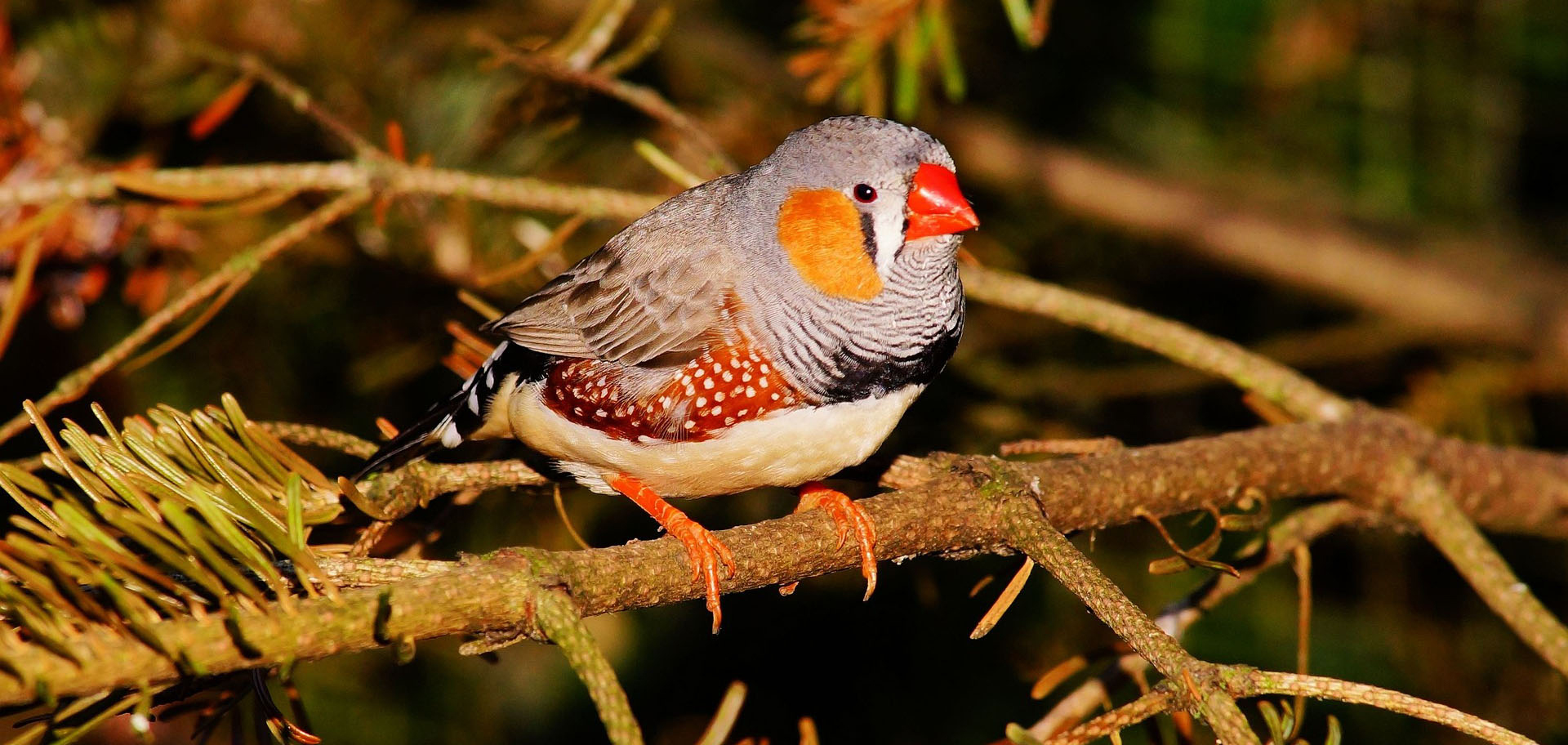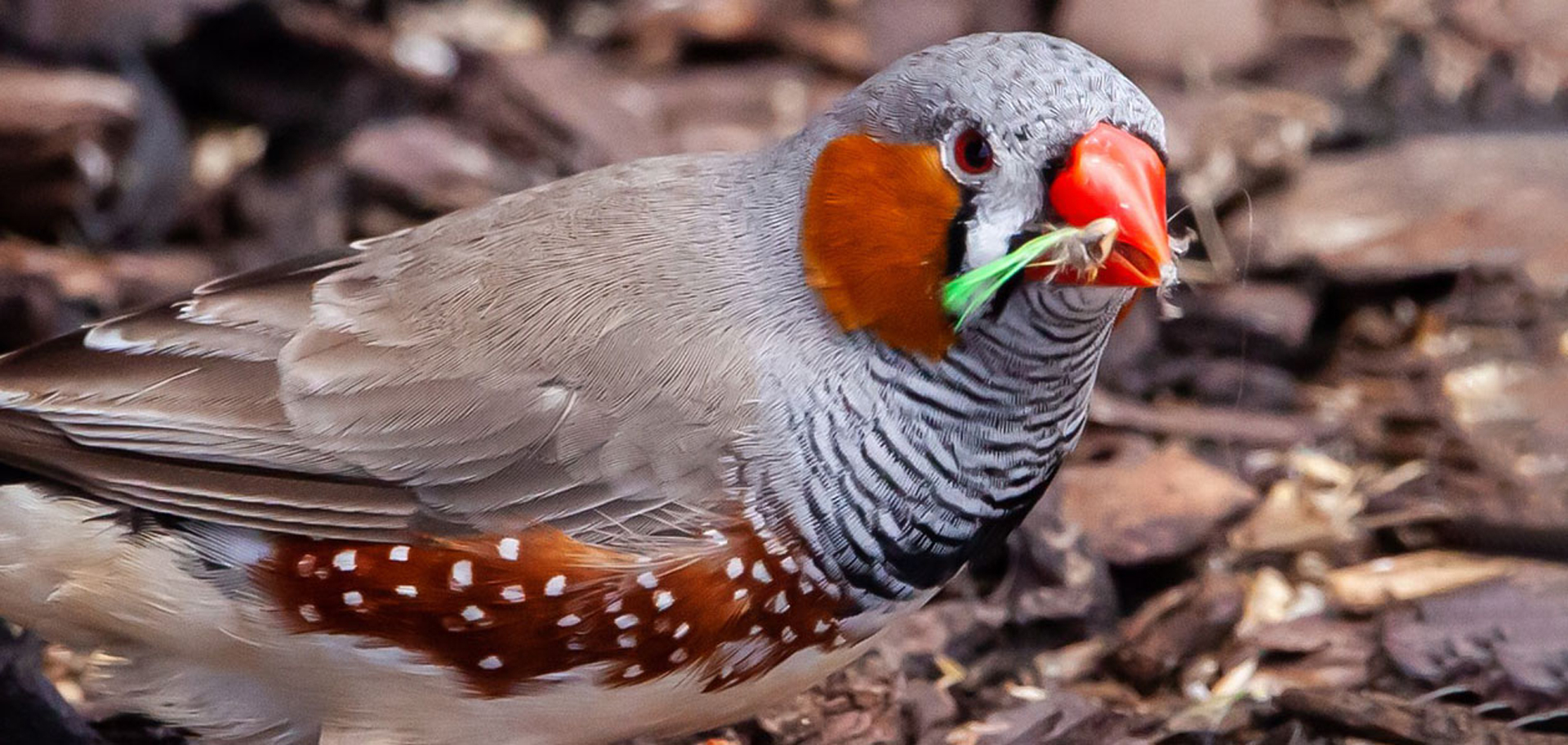
Zebra finches are native to the arid inlands of Australia. They can still be found in very large flocks there.
Although invisible, noise pollution—defined as consistent exposure to elevated sound levels—is real. Also known as environmental noise or sound pollution, noise pollution often takes a back seat to other concerns, such as air, chemical and water pollution, since it cannot be seen, smelled or tasted.
Sound is measured in decibels. Rustling leaves measure 20 to 30 decibels, a thunderclap could come in at 120 decibels and the wail of a siren is often 120 to 140 decibels. Sounds that reach 85 decibels or higher can harm a person’s ears. Sound sources that exceed this threshold include familiar things, such as power lawn mowers (90 decibels), subway trains (90 to 115 decibels) and loud rock concerts (110 to 120 decibels).
According to the U.S. Environmental Protection Agency, exposure to constant or high levels of noise can cause countless health issues, adversely affects the lives of millions of people. Problems related to noise include hearing loss, high blood pressure, speech interference, sleep disruption, stress-related illnesses and lost productivity.

The sound of rustling leaves measures just 20 to 30 decibels (dB). In comparison, the sound of breathing is 10 dB, whispering from five feet away is 30 dB, quiet library sounds are 40 dB, a running refrigerator is 50 dB and an electric toothbrush is 60 dB.
But does anthropogenic noise (that generated from human activities) affect other species? The answer is yes—and heavily. One recent study indicates that dolphins are now “shouting” when trying to work together when it is louder underwater.
And it’s not only in the oceans that noise pollution is influencing animals. Urban noise has been found to cause birds to take longer to learn a new foraging task and an association learning task. Urban noise has also resulted in male zebra finches developing less bright beaks and females having beaks with a brighter orange coloration, influencing social interactions and mate choice, ultimately decreasing their chances for survival.
Detrimental effects of noise on dolphins
Highly intelligent and social, dolphins rely on echolocation and whistles to hunt, reproduce and otherwise live their lives. This means that anthropogenic noise, such as the sounds from drilling and shipping, has the potential to negatively impact the health of wild dolphin populations.

Power lawn mowers are usually 90 dB, subway trains are 90 to 115 dB and loud rock concerts can be 110 to 120 dB.
Since it’s almost impossible to investigate how noise changes the behavior of animals working together in a wild environment, researchers from the University of Bristol in England and international colleagues worked with dolphins at the Dolphin Research Center in Florida. In an experiment, two dolphins, Delta and Reese, were placed in an experimental lagoon and equipped with suction-cup sound recorders to document their vocalizations.
Then, Delta and Reese were given a mission. They had to work together to both press their own underwater button placed at either end of the lagoon within one second of each other. They were released from a starting point during each trial; and for certain trials, one of the dolphins was held back for five to 10 seconds while the other was released immediately. In the delayed-release trials, the dolphins had to rely solely on vocal communications to coordinate the button press.
The researchers found that when increasing levels of noise were played from an underwater speaker, both dolphins compensated by changing the volume and length of their calls to synchronize their pressing of the buttons. From the lowest to highest levels of noise, the dolphins’ success rate dropped from 85 percent to 62.5 percent.

Dolphins struggle to hear each other and cooperate in a world of increasing noise pollution, a new study reveals.
Not only did the dolphins change their calls, but they also changed their body language. As noise levels increased, the dolphins were more likely to reorient themselves to face each other, and they were also more likely to swim to the other side of the lagoon to be closer.
So, despite using these compensatory maneuvers, the dolphins’ communications were impaired by noise. And even though they tried their best to compensate, were highly motivated and knew this cooperative task so well, the noise still damaged their ability to successfully coordinate.
While this research, which was published in the journal Current Biology on January 12, 2023, was conducted with dolphins living in human care, the noise we generate can potentially have detrimental effects on wild dolphins, too. For example, if groups of animals in the wild are less efficient at foraging cooperatively, it will negatively affect their individual health, which ultimately impacts the health of the whole population. The animals’ adjustments to such an environmental stressor as noise may not be enough to overcome the negative effects on their ability to communicate.

Previous studies have found that dolphins whistle at higher frequencies and with less complexity during periods of high noise pollution. Since these animals have complex languages, this simplification could hinder the amount of information being conveyed and therefore diminish their ability to navigate their environments.
The researchers do note that to study this in the wild, they would need further understanding of when animals are actively working together and how cooperative behavior is coordinated.
But for me, what is ironic is that the same reasons that make sound so advantageous for animals to use also makes them susceptible to the noise disturbances that we cause in the environment. And within the last couple of decades, we’ve seen a dramatic increase in human-made noise, under and above water.
Serious consequences of clamor on songbirds
Anthropogenic noise has damaging effects on wildlife not only underwater, but in urban environments, as well. And it not only involves hearing.

Outside of Australia, wild populations of zebra finches live in Indonesia and East Timor. Thriving populations of introduced birds now inhabit Brazil, Puerto Rico and the U.S.
Urban noise contains a wide range of frequencies, types of sounds—such as from traffic—and varying amplitudes, including noises with rapid onset times that can be startling.
While previous studies have shown that noise pollution affects cognitive performance in some animal species including birds, a recent study by researchers at Florida Atlantic University (FAU) is the first to test whether exposure to this noise has any effects on bird beaks.
The FAU scientists tested a songbird native to Australia, the zebra finch. Males have a colorful plumage of black, brown, gray, orange and white; while females are uniformly gray. Males have bright red beaks while females’ beaks are orange. Their beak ornamentation is a social signal and a secondary sexual trait that can signal a male’s quality and affect female mate preferences. Beak color also makes a difference in dominance hierarchies in male zebra finches.

Urban noise is causing changes in the beak colors of zebra finches, which is, in turn, affecting their social interactions and choices of mates.
Two separate experiments were conducted to determine the effects of anthropogenic noise on cognition, beak color and growth in zebra finches. In the first experiment, they tested adult zebra finches on a series of cognition tests while they were exposed to playbacks of urban noise versus birds tested without noise.
For the second experiment, researchers measured the cognitive performance of adult zebra finches on foraging tasks after raising them with consistent exposure to urban noise. They compared their performance to birds raised with exposure to “pink noise” (examples include rustling leaves, steady rainfall or waves; pink noise reduces the difference between the background hum and loud, jarring noises) or with exposure to the normal sounds of the aviary. They also tracked their growth and the development of their beak coloration during the first 90 days of life. They then tested the birds on the series of cognition tests once they reached adulthood.
Results of the study, published in the journal Acta Ethologica in December 2022, showed that urban noises caused the birds to take longer to learn a novel foraging task and to learn an association learning task. While urban noise exposure during development did not alter growth rates or adult body sizes, males did develop less bright beak coloration; while females’ beaks became a brighter orange compared with untreated birds.

No sound of rustling leaves; no birdsong; no humming of insects; no airplanes overhead or ship clangor. The silence I heard in Alaska’s Glacier Bay National Park was startling. ©Fred von Lohmann, flickr
The researchers say that their findings suggest that urban noise exposure can change morphological traits, such as beak color, which influence social interactions and mate choice. Urban noise can also cause negative effects on traits such as problem-solving and neophobia, or fear of new things.
Prominent impact of silence on peace
Like air, electricity and gravity, sound is a powerful force. It’s crucial for our brain development. For instance, playing an instrument benefits a growing human brain. Speaking two languages, another form of sound enrichment, is good for attentional skills and multitasking; and it may prevent the onset of dementia. Nonhuman animals, too, depend on sounds that are necessary for their survival.
But the lack of sound, too, can fill us with wonder.
The challenge is finding a balance between the sounds that we all require to thrive, and the lack of them that we all desire to nourish our spirits.
Here’s to finding your true places and natural habitats,
Candy






























